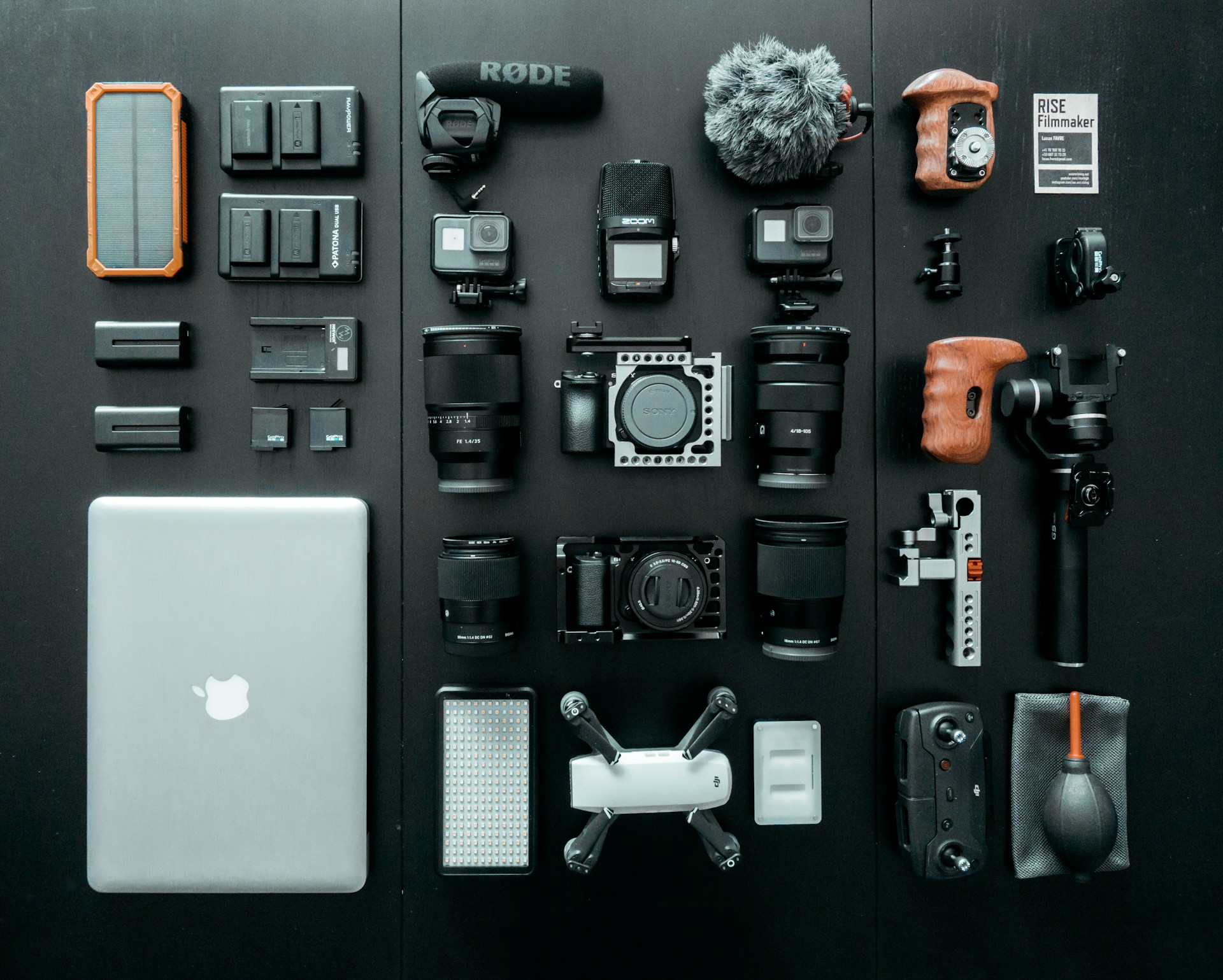Embarking on the journey of video production for beginners is an exhilarating endeavor filled with creative potential. This comprehensive guide aims to demystify the process, offering insights into gear selection, pre-production planning, video production setups, and the nuances of post-production editing. Whether you’re a novice or looking to refine your skills, this guide is your roadmap to successful video creation.

Choosing the Right Gear Sets
1. Beginner Video Kit (Approx. $200)
For those diving into video production for beginners, consider the simplicity and affordability of a smartphone paired with a lavalier microphone, tripod, and ring light—a complete package at around $200. Alternatively, a laptop with a 1080p webcam and USB or Bluetooth microphone is a viable option, totaling approximately $300. This gear is ideal for crafting sales videos, blog content, and budget-friendly productions, offering exceptional portability for shooting in various locations.
2. Intermediate Video Kit ($1,500 – $1,700)
As you progress beyond video production for beginners, the intermediate kit introduces a DSLR camera, 50mm lens, wireless microphone, tripod, and lighting kit, with a total cost ranging from $1,500 to $1,700. This setup caters to higher-quality footage suitable for customer testimonials, scripted videos, and productions with medium-to-high production value.
3. Advanced Video Kit ($9,000 – $10,000)
Venturing into advanced video production for beginners involves investing in high-quality gear, including a premium video camera, lens adaptor, 50mm lens, 24-105 f4 lens, shotgun microphone, wireless lavalier microphone, tripod, and a full light kit. While the total cost is substantial, ranging from $9,000 to $10,000, this setup ensures the capture of the highest quality images, suitable for brand videos, TV commercials, and more extensive productions.

Video Editing Software
Navigating the realm of video production for beginners also requires considerations for video editing software. Basic options like QuickTime or iMovie are readily available on most computers. However, advanced software like Camtasia and Adobe Premiere, while more feature-rich, may pose challenges in terms of user familiarity and time investment. Additionally, exciting advancements in AI video editing tools are streamlining the editing process, making it quicker and more accessible for beginners.
One good options would be premiere pro by adobe
Video Pre-Production
Contrary to common perception, the production stage of video production for beginners is relatively short. The pre-production phase, involving planning, scripting, storyboarding, and casting, is the foundation for a successful project. Avoiding errors in this phase is crucial to prevent delays and ensure a smooth progression.
To streamline pre-production in video production for beginners, nominate a responsible video producer who oversees crucial elements such as:
- Developing a detailed video timeline, starting with the launch day and working backward.
- Creating a comprehensive video creative brief, outlining the video’s purpose, target audience, tone, budget, and required materials.
- Establishing a realistic video budget, aligning with the desired return on investment (ROI) in terms of leads or pipeline.
- Crafting a video script, detailing the chronological order of events and dialogue.
- Creating a visual video storyboard, frame by frame, without the need for advanced art skills.
- Recruiting video talent, either from within the company or, for larger-scale productions, considering professional actors.

Video Production
Efficient video production for beginners hinges on meticulous planning and the mantra of capturing more footage than necessary. This ensures flexibility during the editing phase, avoiding the need for reshoots and minimizing disruptions to the timeline.
Video Production Setup
For video production for beginners, a comprehensive checklist is essential to guarantee all necessary elements are in place. Key considerations include:
- Charging all devices the day before.
- Bringing extra batteries.
- Filming locations during the scouting phase to ensure they look good on camera on shoot day.
- Marking off filming areas with caution tape or traffic cones and informing everyone in that location about the shooting hours.
Lighting for Video Production
In smaller productions, natural light is often the best choice. For indoor lighting rigs, a classic three-point setup—utilizing a key light, fill light, and backlight—eliminates harsh shadows, contributing to a polished look in video production for beginners.
Shot Composition
Adhering to the rule of thirds is vital in video production for beginners. Dividing the screen into three sections horizontally and vertically guides the placement of subjects, avoiding the center of the frame. Additionally, refraining from shooting in portrait mode is crucial unless specifically targeting social media platforms.
Audio for Video
Testing audio quality before shooting is imperative in video production for beginners. Passive noises can be amplified, impacting the overall sound quality. Instruction actors to speak into microphones and record ambient sound for smooth transitions.
Directing Video Production
Whether a novice or experienced in video production for beginners, the director (often the video producer in smaller teams) runs through the storyboard shot list methodically. Multiple takes per scene help minimize the chances of reshoots, ensuring flexibility during the editing phase.
Camera Basics
Getting comfortable with the camera is key in video production for beginners. Consider the following:
- Understand your focal length to avoid distorting subjects when shooting up close.
- Use gridlines to level out shots.
- Utilize your camera’s capabilities, such as tapping the screen to focus and lock.
Remote Video Production
For situations where in-person shoots are not feasible, video production for beginners can still thrive remotely. Leveraging webcams, video conferencing software, stock footage, animation tools like Vyond, or repurposing existing footage are effective strategies.

Video Post-Production
Post-production marks the editing phase of video production for beginners, where selecting shots, adding effects, and finalizing the video occur. A meticulous approach during pre-production and production expedites this phase.
Upload Videos to Editing Software:- Ensure consistent screen ratios, crucial in video production for beginners.
- Trim Clips:
- Remove unnecessary footage to streamline the storyline.
- Arrange Clips:
- Organize clips chronologically for a cohesive narrative.
- Add Effects:
- While not mandatory, animations, transitions, or graphic overlays can enhance visual appeal.
- Review:
- Seek feedback from individuals not involved in the project for an unbiased perspective.
- Edit Audio:
- Arrange audio elements, smoothing out levels and correcting any issues.
- Correct Color:
- Optionally, perform color correction to enhance the video’s visual appeal.
- Export and Save:
- Save multiple copies and back up to a secondary device or the cloud to prevent data loss.
The Value of Using an Enterprise Video Hosting Platform
For seamless video management, an online video hosting platform like Vidyard becomes essential. These platforms centralize video hosting, sharing, organization, and tracking. Marketers benefit by uploading videos for distribution across websites, landing pages, and emails, while also creating specific hubs for prospects, employees, or sales teams.

How to Make Great Videos: 6 Tips
Now that the mechanics of video production for beginners are mastered, focus on maximizing outcomes within budget and time constraints.
- Speak Lower, Slower, and with Certainty:
- Maintain eye contact, speak in a lower octave, and project confidence to build a connection with viewers.
- Wear Solid Colors:
- Dress appropriately for the audience, opting for solid colors that are easy to view on screen.
- Let the Conversation Flow in Interviews:
- Engage in pre-recording conversations to build rapport and allow interviewees to express themselves.
- Ensure Customer Stories Cover Who, What, and How:
- Structure customer story videos to include the customer’s identity, the problem encountered, and the resolution. A two-camera setup enhances storytelling options.
- Choose Well-Lit, Quiet Locations:
- Prioritize well-lit and noise-free shooting locations for optimal video quality.
- Get Right to the Point in Social Videos:
- Capture attention quickly in social media videos by starting with a surprising clip, followed by an intro sequence.
The Bottom Line
In conclusion, mastering video production for beginners involves strategic gear selection, meticulous pre-production planning, skillful production techniques, and detailed post-production editing. Embrace the learning curve, leverage the tips provided, and remember—the key to successful video creation is taking the first step. As you delve into the world of video production, refer back to this guide for guidance, and watch your skills evolve over time.


